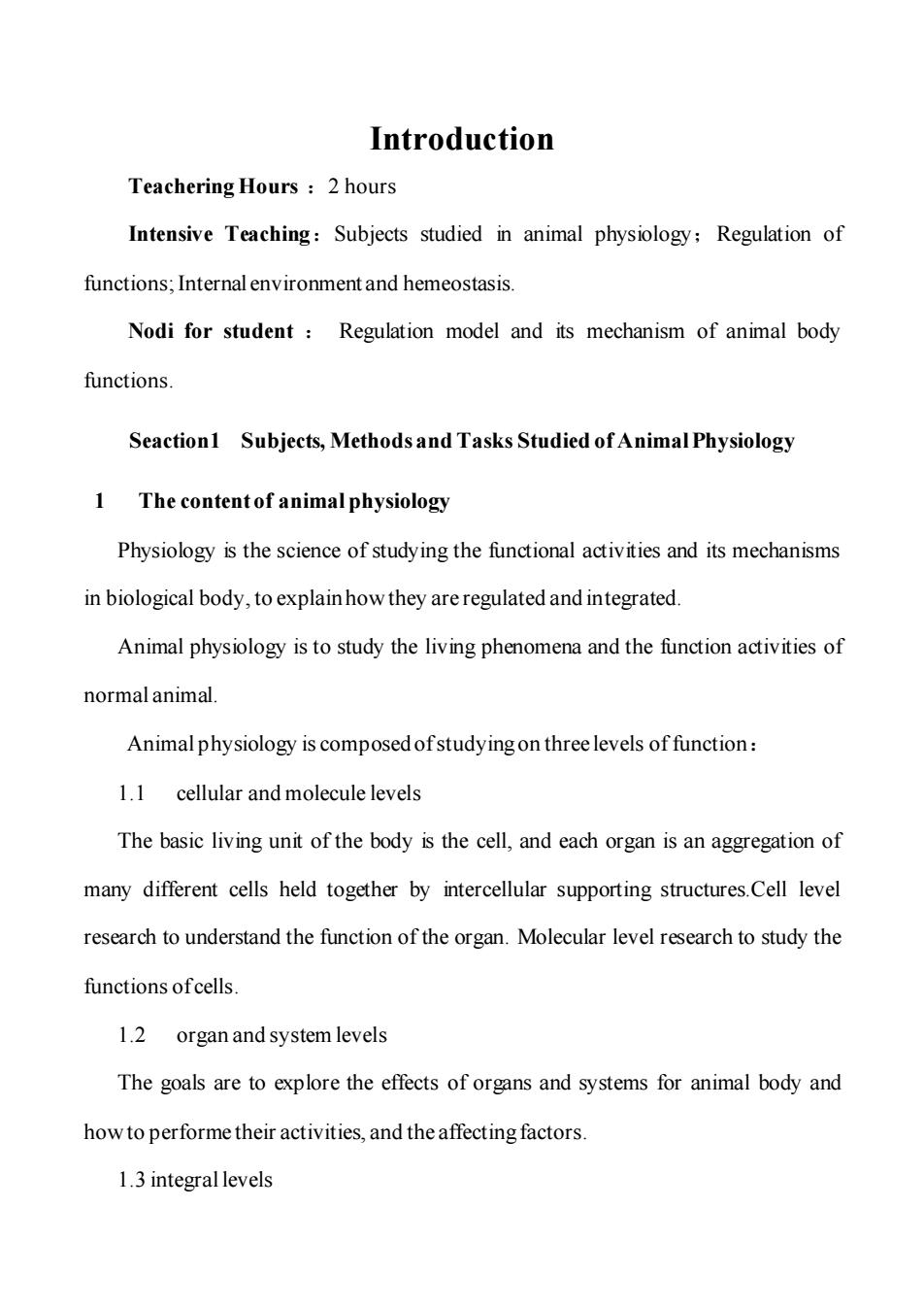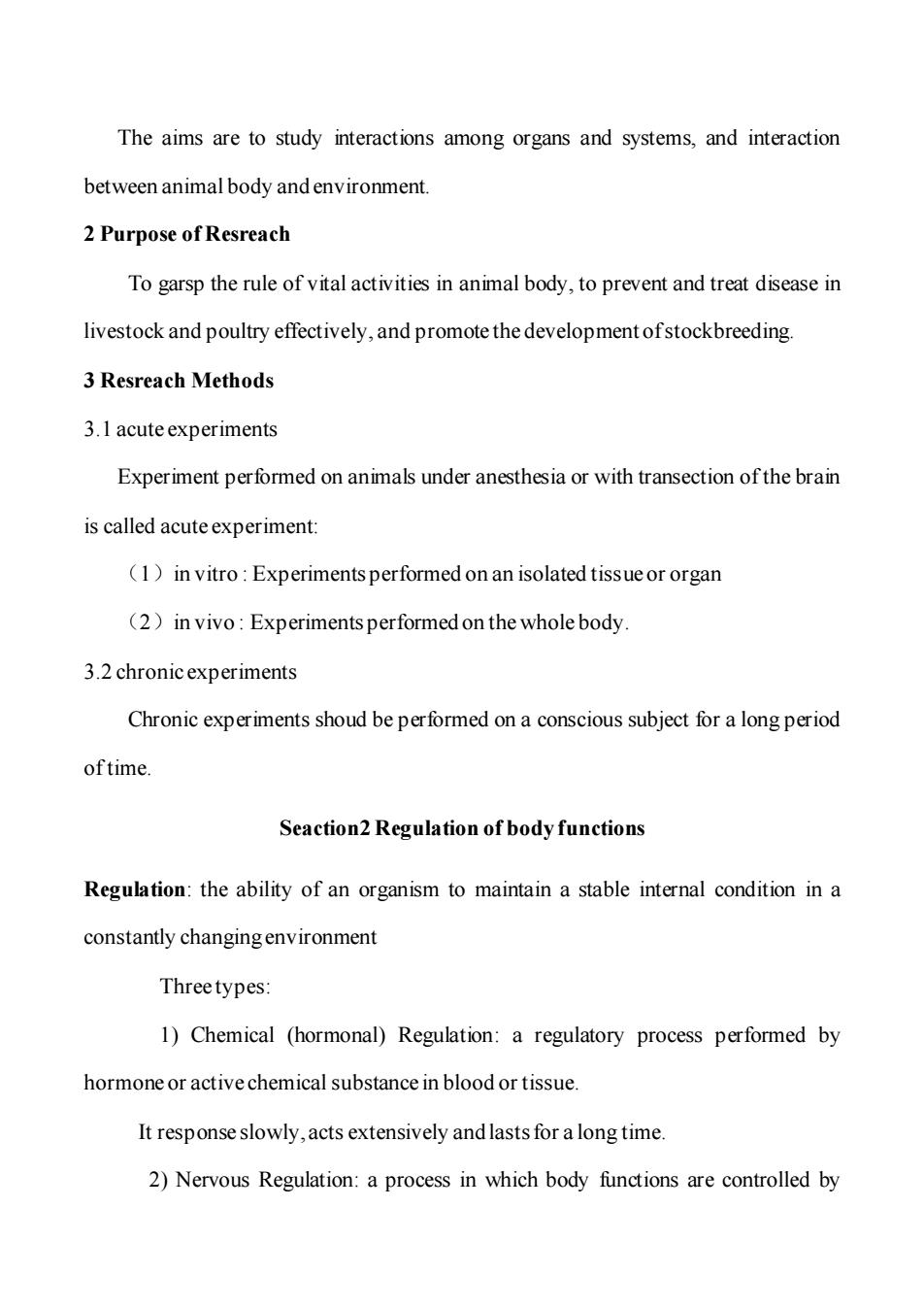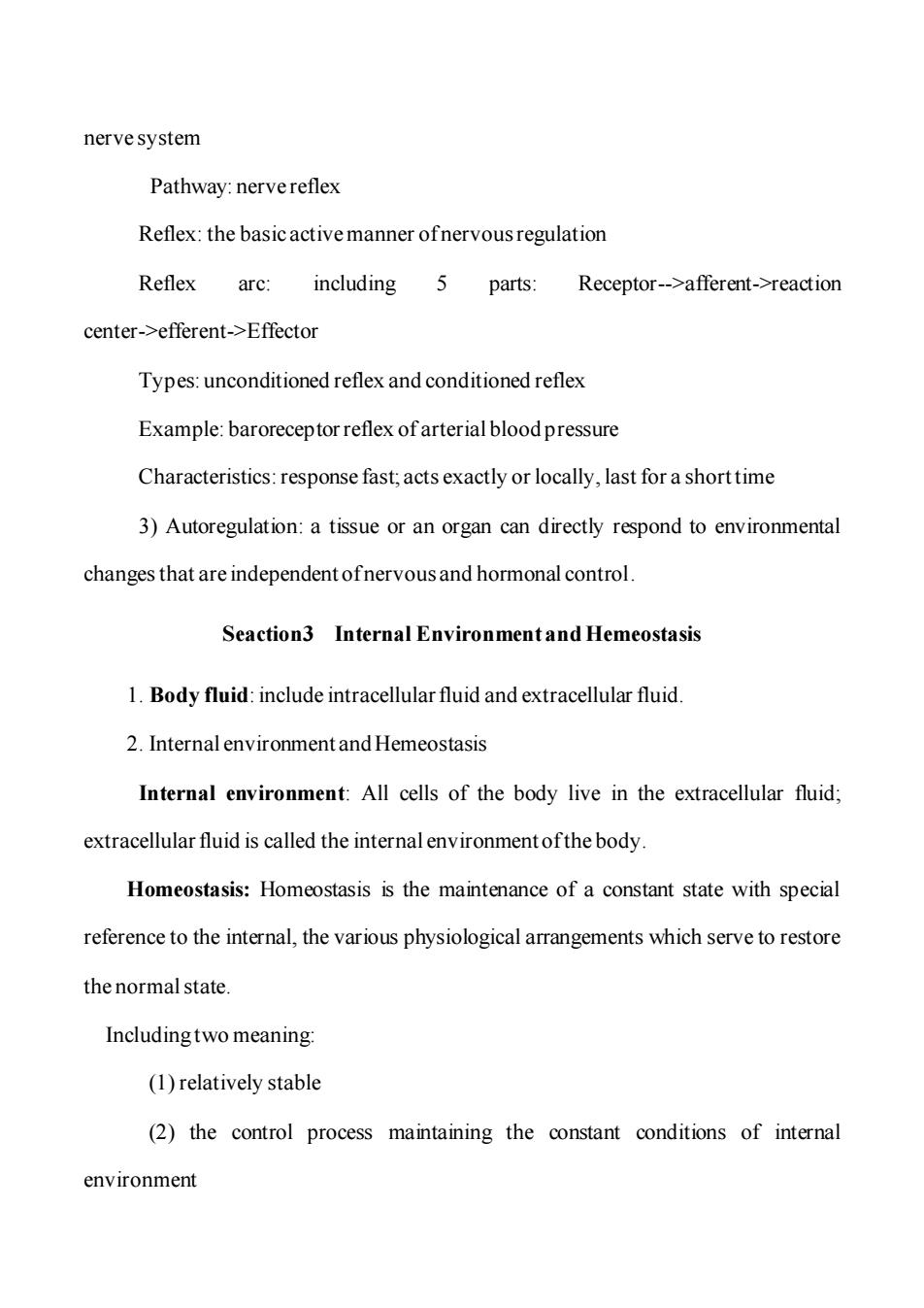
Introduction Teachering Hours 2 hours Intensive Teaching:Subjects studied in animal physiology:Regulation of functions;Internal environment and hemeostasis. Nodi for student Regulation model and its mechanism of animal body functions. Seaction1 Subjects,Methods and Tasks Studied of Animal Physiology The content of animal physiology Physiology is the science of studying the functional activities and its mechanisms in biological body,to explain how they are regulated and integrated. Animal physiology is to study the living phenomena and the function activities of normal animal. Animal physiology is composed ofstudying on three levels of function: 1.1 cellular and molecule levels The basic living unit of the body is the cell,and each organ is an aggregation of many different cells held together by intercellular supporting structures.Cell level research to understand the function of the organ.Molecular level research to study the functions ofcells. 1.2 organ and system levels The goals are to explore the effects of organs and systems for animal body and how to performe their activities,and the affecting factors. 1.3 integral levels
Introduction Teachering Hours :2 hours Intensive Teaching:Subjects studied in animal physiology;Regulation of functions; Internal environment and hemeostasis. Nodi for student : Regulation model and its mechanism of animal body functions. Seaction1 Subjects, Methods and Tasks Studied of Animal Physiology 1 The content of animal physiology Physiology is the science of studying the functional activities and its mechanisms in biological body, to explain how they are regulated and integrated. Animal physiology is to study the living phenomena and the function activities of normal animal. Animal physiology is composed of studying on three levels of function: 1.1 cellular and molecule levels The basic living unit of the body is the cell, and each organ is an aggregation of many different cells held together by intercellular supporting structures.Cell level research to understand the function of the organ. Molecular level research to study the functions of cells. 1.2 organ and system levels The goals are to explore the effects of organs and systems for animal body and how to performe their activities, and the affecting factors. 1.3 integral levels

The aims are to study interactions among organs and systems,and interaction between animal body and environment. 2 Purpose of Resreach To garsp the rule of vital activities in animal body,to prevent and treat disease in livestock and poultry effectively,and promote the development ofstockbreeding. 3 Resreach Methods 3.1 acute experiments Experiment performed on animals under anesthesia or with transection of the brain is called acute experiment: (1)in vitro:Experiments performed on an isolated tissue or organ (2)in vivo:Experiments performed on the whole body. 3.2 chronicexperiments Chronic experiments shoud be performed on a conscious subject for a long period oftime. Seaction2 Regulation of body functions Regulation:the ability of an organism to maintain a stable internal condition in a constantly changing environment Three types: 1)Chemical (hormonal)Regulation:a regulatory process performed by hormone or active chemical substance in blood or tissue. It response slowly,acts extensively and lasts for a long time. 2)Nervous Regulation:a process in which body functions are controlled by
The aims are to study interactions among organs and systems, and interaction between animal body and environment. 2 Purpose of Resreach To garsp the rule of vital activities in animal body, to prevent and treat disease in livestock and poultry effectively, and promote the development of stockbreeding. 3 Resreach Methods 3.1 acute experiments Experiment performed on animals under anesthesia or with transection of the brain is called acute experiment: (1)in vitro : Experiments performed on an isolated tissue or organ (2)in vivo : Experiments performed on the whole body. 3.2 chronic experiments Chronic experiments shoud be performed on a conscious subject for a long period of time. Seaction2 Regulation of body functions Regulation: the ability of an organism to maintain a stable internal condition in a constantly changing environment Three types: 1) Chemical (hormonal) Regulation: a regulatory process performed by hormone or active chemical substance in blood or tissue. It response slowly, acts extensively and lasts for a long time. 2) Nervous Regulation: a process in which body functions are controlled by

nerve system Pathway:nerve reflex Reflex:the basic active manner ofnervous regulation Reflex arc: including 5 parts: Receptor-->afferent->reaction center->efferent->Effector Types:unconditioned reflex and conditioned reflex Example:baroreceptor reflex ofarterial blood pressure Characteristics:response fast;acts exactly or locally,last for a short time 3)Autoregulation:a tissue or an organ can directly respond to environmental changes that are independent ofnervous and hormonal control. Seaction3 Internal Environment and Hemeostasis 1.Body fluid:include intracellular fluid and extracellular fluid 2.Internal environment and Hemeostasis Internal environment:All cells of the body live in the extracellular fluid; extracellular fluid is called the internal environment of the body. Homeostasis:Homeostasis is the maintenance of a constant state with special reference to the internal,the various physiological arrangements which serve to restore the normal state. Includingtwo meaning: (1)relatively stable (2)the control process maintaining the constant conditions of internal environment
nerve system Pathway: nerve reflex Reflex: the basic active manner of nervous regulation Reflex arc: including 5 parts: Receptor-->afferent->reaction center->efferent->Effector Types: unconditioned reflex and conditioned reflex Example: baroreceptor reflex of arterial blood pressure Characteristics: response fast; acts exactly or locally, last for a short time 3) Autoregulation: a tissue or an organ can directly respond to environmental changes that are independent of nervous and hormonal control. Seaction3 Internal Environment and Hemeostasis 1. Body fluid: include intracellular fluid and extracellular fluid. 2. Internal environment and Hemeostasis Internal environment: All cells of the body live in the extracellular fluid; extracellular fluid is called the internal environment of the body. Homeostasis: Homeostasis is the maintenance of a constant state with special reference to the internal, the various physiological arrangements which serve to restore the normal state. Including two meaning: (1) relatively stable (2) the control process maintaining the constant conditions of internal environment

Function:All of the organs and tissues perform function to help maintain these constant conditions
Function: All of the organs and tissues perform function to help maintain these constant conditions